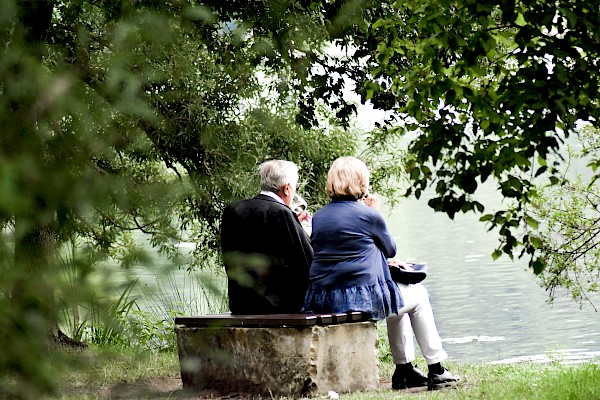Need a Hug?
National Hugging Day takes place every year on 21 January. Do you like giving other people a hug? Do you feel good when you do, or do you not particularly like physical closeness? The need for physical contact varies from person to person. Mostly we enjoy being hugged or touched by people we know well and like. But hugs are only one sort of physical closeness. In this blog, we’d like to show you what happens in the body during congenial physical contact and how important physical closeness is for our health.
The importance of the sense of touch
The sense of touch is the first sense that humans develop. We know when we are being touched before we can see or hear. In the womb, we are in contact with the amniotic fluid, we can feel our own bodies and can perceive and respond to touching through the mother’s abdominal wall. After birth, physical contact and touching are hugely important for infants to develop properly, both physically and mentally. Later, small children use their sense of touch to explore the environment around them and to understand it. Everything is grasped and explored with the fingers.
A key function of touching and physical closeness is non-verbal communication. By using touch contact such as hugging, a gentle squeeze of the hand, social pecks on the cheek to say hello or a hand on someone’s shoulder, we can express concern, empathy, comfort, friendship, affection, joy, appreciation and many other things. We use touch to signal closeness. We really are there, and we can help, if support becomes necessary. This also plays an important role in loneliness. There are indications that people who experience frequent physical contact feel less lonely. Touch is therefore also a way of conveying social support. Many studies have demonstrated that social support is a positive factor for our health. Perceived support can reduce stress and protect us from depression and anxiety, among other things.
«A warm embrace generates happiness, because two hearts come closer together.»
- Franz Schmidberger -
What are the effects of touching on our health?
When we want to be touched, and when being touched makes us feel good, our bodies release the hormone oxytocin. Oxytocin is known as a bonding hormone, and it helps to reduce stress. Our blood pressure and cortisol levels decrease during physical contact. Anxiety may be reduced and even pain lessens. Our immune systems are also positively affected. Oxytocin boosts our wellbeing and promotes feelings of trust and empathy between people. Massages seem to be particularly beneficial for our health. They activate self-healing processes even in babies, relieve tension and strengthen the immune system. Many of the above health benefits of touching have been demonstrated during massage.
Not everyone likes physical closeness to the same extent.
Liking hugs, social air kisses, massages and any other form of physical touch is highly personal. What’s more, touching is also cultural. In some cultures, physical contact is part of daily life. By contrast, other cultures abstain from touching almost entirely (e.g., handshakes). For example, do you know the person whose shoulder you have put your hand on? – this also plays a role. Imagine that someone on the bus puts their hand on your shoulder. You will certainly not appreciate this if you don’t know the person. However, if they are a member of your circle of friends, you will enjoy the touch. It is important that we respect other people’s personal boundaries, and keep to them, because unwanted touching can negatively affect us and our health in many different ways.
How do you experience physical closeness? Do you like hugs? When was the last time you got, or gave, a big hug?
«Sometimes, you don’t need words, you need a hug.»
− Unknown −
References
Becker, K. (Moderator). (2020, 21 December). Kuscheln, Streicheln: Warum uns körperliche Nähe guttut [Audio-Podcast]. In Kontext. Schweizer Radio und Fernsehen. https://www.srf.ch/audio/kontext/kuscheln-streicheln-warum-uns-koerperliche-naehe-guttut?partId=11897846
Cohen, S., Janicki-Deverts, D., Turner, R. B., & Doyle, W. J. (2015). Does hugging provide stress-buffering social support? A study of susceptibility to upper respiratory infection and illness. Psychological science, 26(2), 135-147. https://doi.org/10.1177/0956797614559284
Field, T. (2010). Touch for socioemotional and physical well-being: A review. Developmental review, 30(4), 367-383. https://doi.org/10.1016/j.dr.2011.01.001
Heatley Tejada, A., Dunbar, R. I. M., & Montero, M. (2020). Physical contact and loneliness: being touched reduces perceptions of loneliness. Adaptive human behavior and physiology, 6(3), 292-306. https://doi.org/10.1007/s40750-020-00138-0
Jakubiak, B. K., & Feeney, B. C. (2019). Interpersonal touch as a resource to facilitate positive personal and relational outcomes during stress discussions. Journal of Social and Personal Relationships, 36(9), 2918-2936. https://doi.org/10.1177/0265407518804666
Simon, R. (2022, 21 January). Körperliche Nähe als wichtiger Grundbaustein zwischenmenschlicher Beziehungen. Technische Universität Dresden. https://tu-dresden.de/gsw/der-bereich/news/koerperliche-naehe-als-wichtiger-grundbaustein-zwischenmenschlicher-beziehungen
Von Mohr, M., Kirsch, L. P., & Fotopoulou, A. (2021). Social touch deprivation during COVID-19: effects on psychological wellbeing and craving interpersonal touch. Royal Society open science, 8(9), 210287. https://doi.org/10.1098/rsos.210287
 subscribe to newsletter
subscribe to newsletter


